air conditioning Citroen DS3 2011 1.G Owner's Manual
[x] Cancel search | Manufacturer: CITROEN, Model Year: 2011, Model line: DS3, Model: Citroen DS3 2011 1.GPages: 324, PDF Size: 25.11 MB
Page 5 of 324
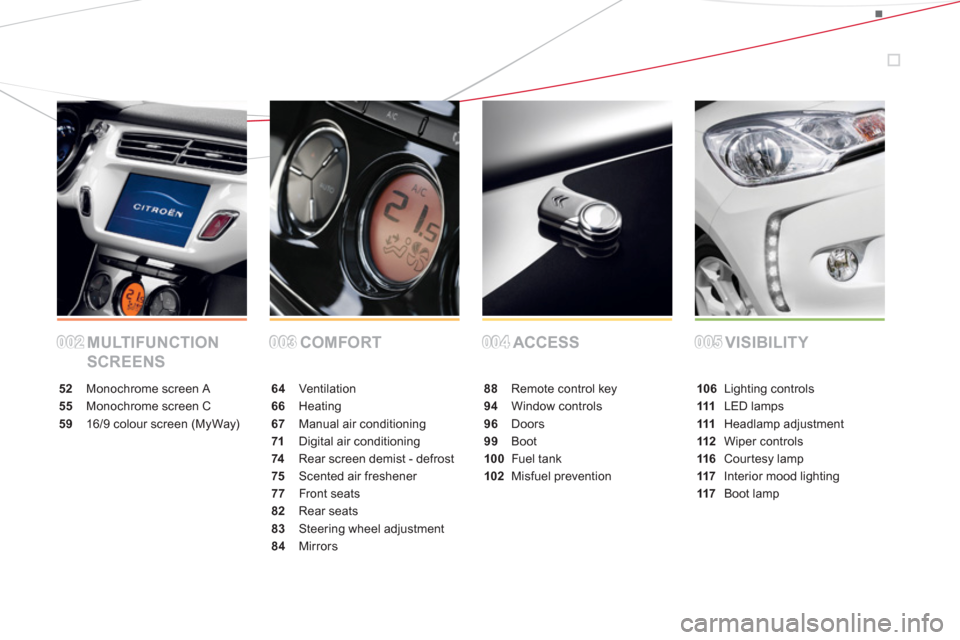
MULTIFUNCTION
SCREENS COMFORT ACCESS VISIBILITY
52 Monochrome screen A
55 Monochrome screen C
59 16/9 colour screen (MyWay)64 Ventilation
66 Heating
67 Manual air conditioning
71 Digital air conditioning
74 Rear screen demist - defrost
75 Scented air freshener
77 Front seats
82 Rear seats
83 Steering wheel adjustment
84 Mirrors88 Remote control key
94 Window controls
96 Doors
99 Boot
100 Fuel tank
102 Misfuel prevention106 Lighting controls
111 LED lamps
111 Headlamp adjustment
112 Wiper controls
116 Courtesy lamp
117 Interior mood lighting
117 Boot lamp
004004005005002002003003
Page 12 of 324
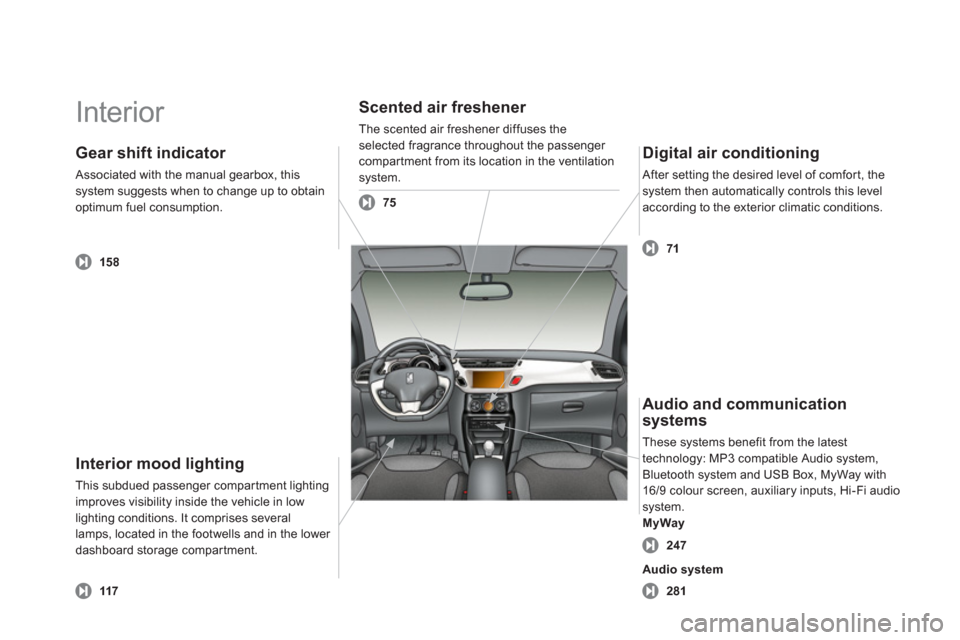
Interior
Interior mood lighting
This subdued passenger compar tment lighting
improves visibility inside the vehicle in low
lighting conditions. It comprises several
lamps, located in the footwells and in the lower
dashboard storage compar tment.
Gear shift indicator
Associated with the manual gearbox, this
system suggests when to change up to obtain
optimum fuel consumption.
Scented air freshener
The scented air freshener diffuses the
selected fragrance throughout the passenger
compartment from its location in the ventilation
system.
Digital air conditioning
After setting the desired level of comfor t, the
system then automatically controls this level
according to the exterior climatic conditions.
117
15 8
75
71
281
Audio and communication
systems
These systems benefit from the latest
technology: MP3 compatible Audio system,
Bluetooth system and USB Box, MyWay with
16/9 colour screen, auxiliary inputs, Hi-Fi audio
system.
MyWay
247
Audio system
Page 14 of 324
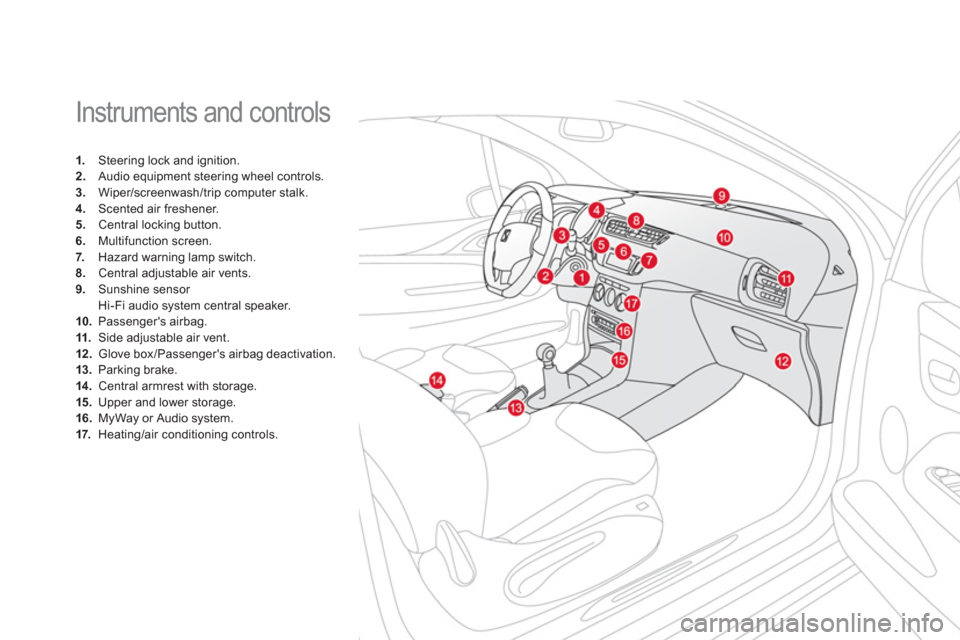
Instruments and controls
1.
Steering lock and ignition.
2.
Audio equipment steering wheel controls.
3.
Wiper/screenwash/trip computer stalk.
4.
Scented air freshener.
5.
Central locking button.
6.
Multifunction screen.
7.
Hazard warning lamp switch.
8.
Central adjustable air vents.
9.
Sunshine sensor
Hi-Fi audio system central speaker.
10.
Passenger's airbag.
11.
Side adjustable air vent.
12 .
Glove box /Passenger's airbag deactivation.
13.
Parking brake.
14 .
Central armrest with storage.
15.
Upper and lower storage.
16.
MyWay or Audio system.
17.
Heating/air conditioning controls.
Page 19 of 324
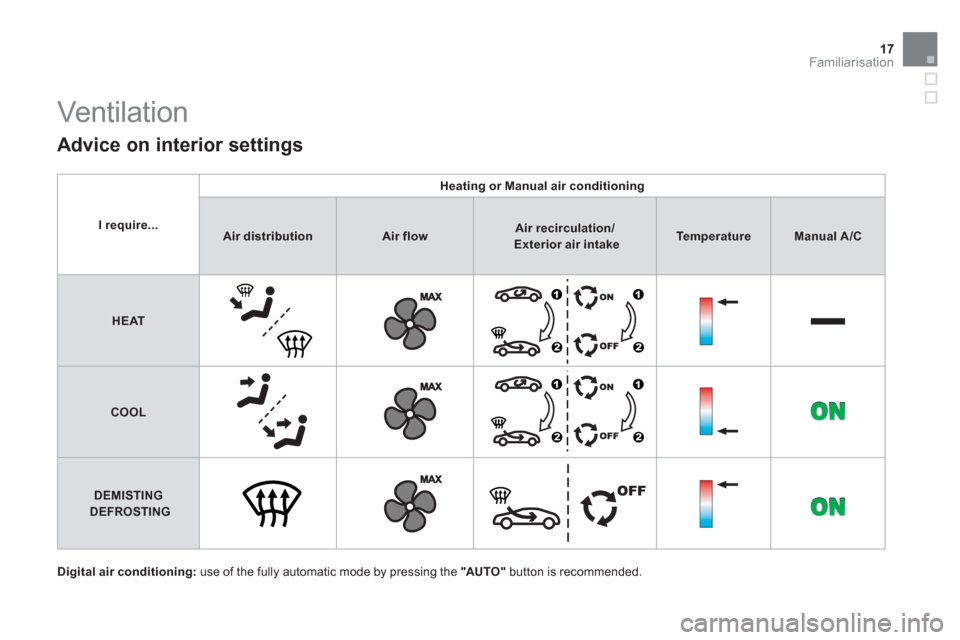
17Familiarisation
Vent ilat ion
Advice on interior settings
Digital air conditioning:
use of the fully automatic mode by pressing the "AU TO "
button is recommended.
I require...
Heating or Manual air conditioning
Air distribution
Air flow
Air recirculation/
Exterior air intake
Te m p e r a t u r e
Manual A/C
HEAT
COOL
DEMISTING
DEFROSTING
Page 24 of 324
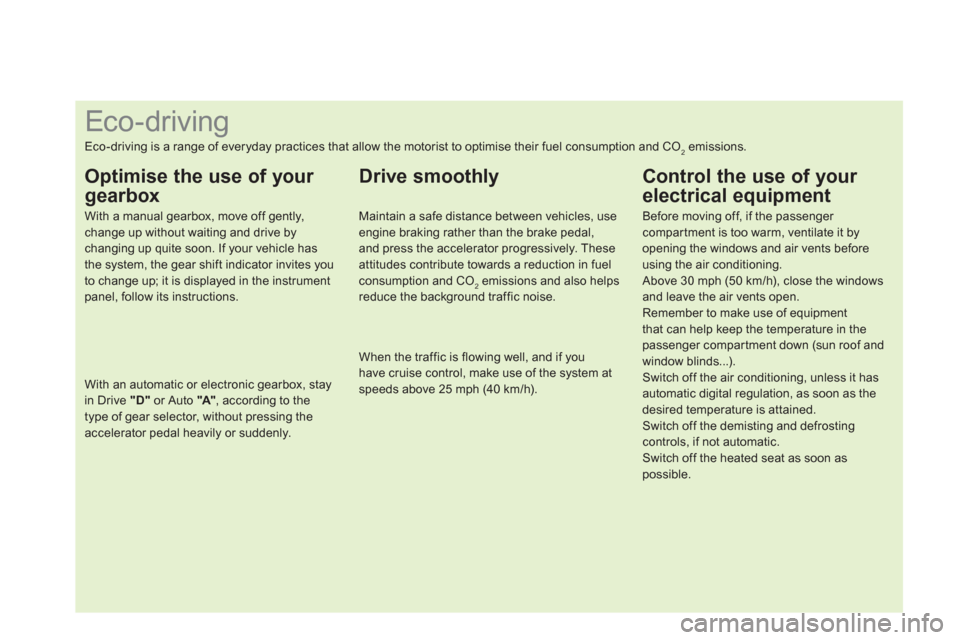
Eco-driving
Eco-driving is a range of everyday practices that allow the motorist to optimise their fuel consumption and CO2 emissions.
Optimise the use of your
gearbox
With a manual gearbox, move off gently,
change up without waiting and drive by
changing up quite soon. If your vehicle has
the system, the gear shift indicator invites you
to change up; it is displayed in the instrument
panel, follow its instructions.
With an automatic or electronic gearbox, stay
in Drive "D"
or Auto "A"
, according to the
type of gear selector, without pressing the
accelerator pedal heavily or suddenly.
Drive smoothly
Maintain a safe distance between vehicles, use
engine braking rather than the brake pedal,
and press the accelerator progressively. These
attitudes contribute towards a reduction in fuel
consumption and CO
2 emissions and also helps
reduce the background traffic noise.
When the traffic is flowing well, and if you
have cruise control, make use of the system at
speeds above 25 mph (40 km/h).
Control the use of your
electrical equipment
Before moving off, if the passenger
compartment is too warm, ventilate it by
opening the windows and air vents before
using the air conditioning.
Above 30 mph (50 km/h), close the windows
and leave the air vents open.
Remember to make use of equipment
that can help keep the temperature in the
passenger compar tment down (sun roof and
window blinds...).
Switch off the air conditioning, unless it has
automatic digital regulation, as soon as the
desired temperature is attained.
Switch off the demisting and defrosting
controls, if not automatic.
Switch off the heated seat as soon as
possible.
Page 64 of 324
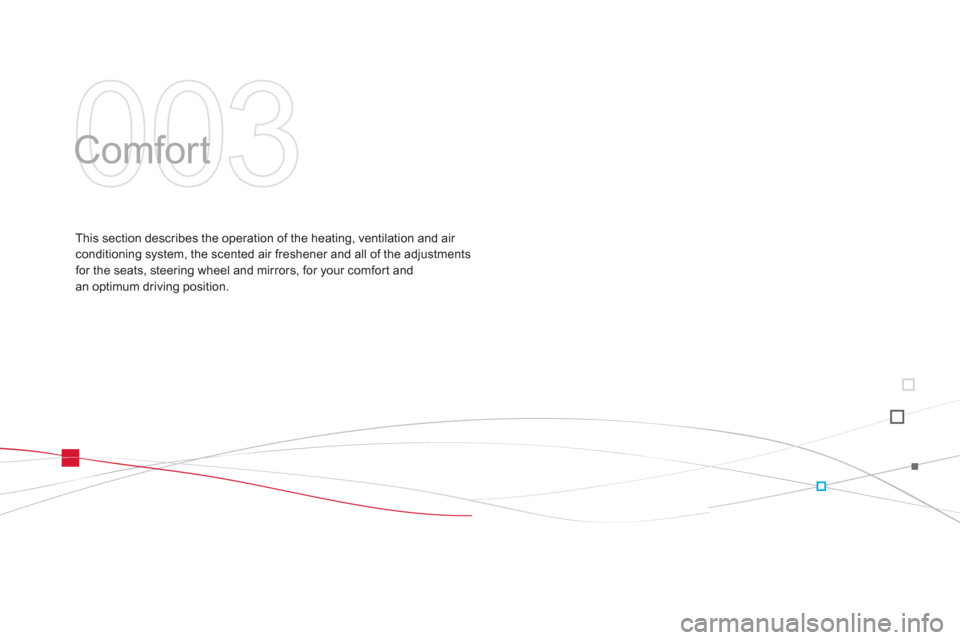
003
Comfort
This section describes the operation of the heating, ventilation and air
conditioning system, the scented air freshener and all of the adjustments
for the seats, steering wheel and mirrors, for your comfort and
an optimum driving position.
Page 66 of 324
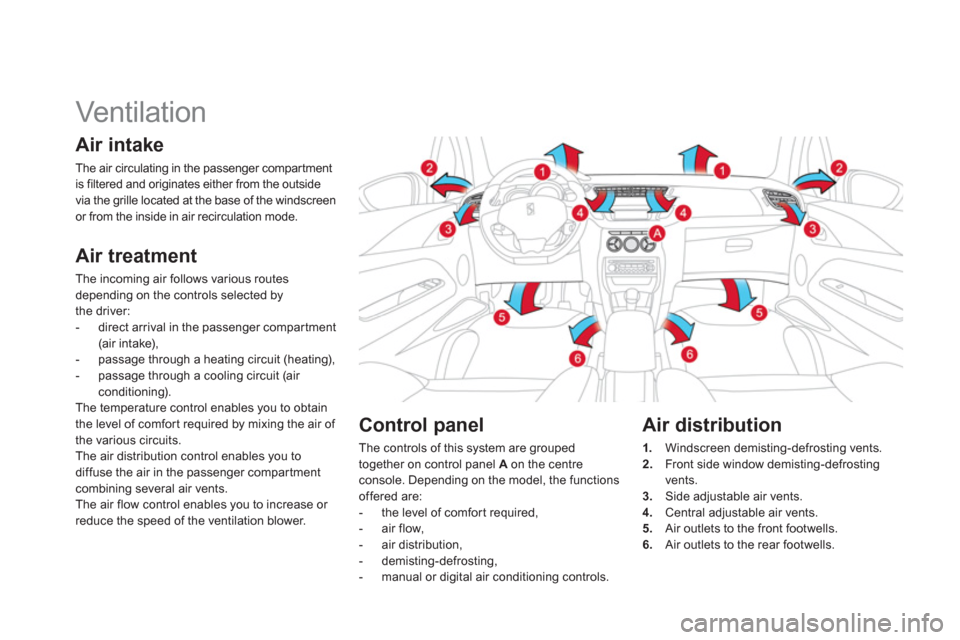
Vent ilat ion
Air intake
The air circulating in the passenger compar tment
is filtered and originates either from the outside
via the grille located at the base of the windscreen
or from the inside in air recirculation mode.
Air treatment
The incoming air follows various routes
depending on the controls selected by
the driver:
- direct arrival in the passenger compartment
(air int ake),
- passage through a heating circuit (heating),
- passage through a cooling circuit (air
conditioning).
The temperature control enables you to obtain
the level of comfor t required by mixing the air of
the various circuits.
The air distribution control enables you to
diffuse the air in the passenger compar tment
combining several air vents.
The air flow control enables you to increase or
reduce the speed of the ventilation blower.
Control panel
The controls of this system are grouped
together on control panel A
on the centre
console. Depending on the model, the functions
offered are:
- the level of comfor t required,
- air flow,
- air distribution,
- demisting-defrosting,
- manual or digital air conditioning controls.
Air distribution
1.
Windscreen demisting-defrosting vents.
2.
Front side window demisting-defrosting
vents.
3.
Side adjustable air vents.
4.
Central adjustable air vents.
5.
Air outlets to the front footwells.
6.
Air outlets to the rear footwells.
Page 67 of 324
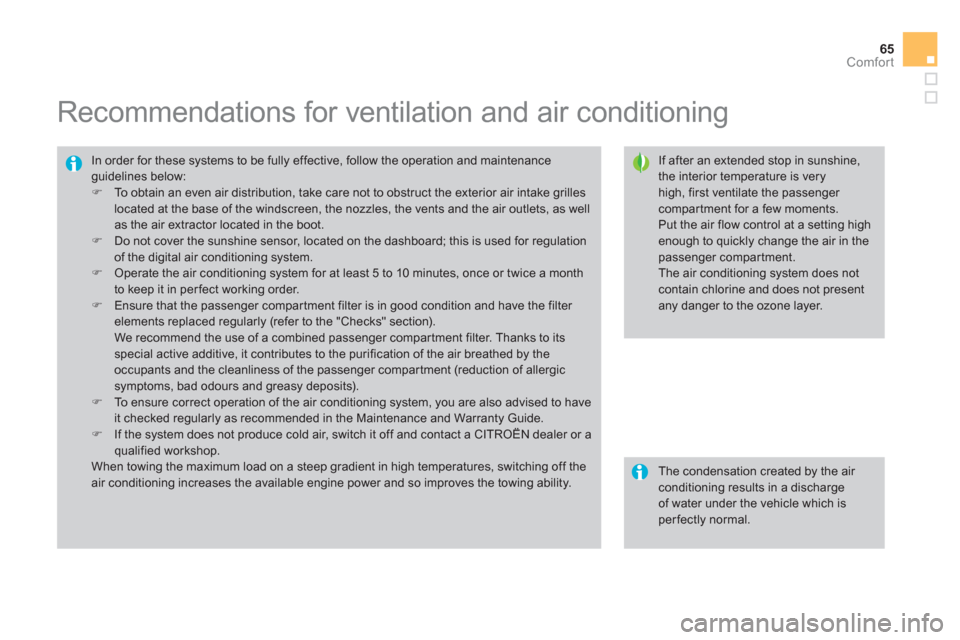
65Comfort
Recommendations for ventilation and air conditioning
If after an extended stop in sunshine,
the interior temperature is very
high, first ventilate the passenger
compartment for a few moments.
Put the air flow control at a setting high
enough to quickly change the air in the
passenger compartment.
The air conditioning system does not
contain chlorine and does not present
any danger to the ozone layer. In order for these systems to be fully effective, follow the operation and maintenance
guidelines below:
�)
To obtain an even air distribution, take care not to obstruct the exterior air intake grilles
located at the base of the windscreen, the nozzles, the vents and the air outlets, as well
as the air extractor located in the boot.
�)
Do not cover the sunshine sensor, located on the dashboard; this is used for regulation
of the digital air conditioning system.
�)
Operate the air conditioning system for at least 5 to 10 minutes, once or twice a month
to keep it in per fect working order.
�)
Ensure that the passenger compartment filter is in good condition and have the filter
elements replaced regularly (refer to the "Checks" section).
We recommend the use of a combined passenger compartment filter. Thanks to its
special active additive, it contributes to the purification of the air breathed by the
occupants and the cleanliness of the passenger compartment (reduction of allergic
symptoms, bad odours and greasy deposits).
�)
To ensure correct operation of the air conditioning system, you are also advised to have
it checked regularly as recommended in the Maintenance and Warranty Guide.
�)
If the system does not produce cold air, switch it off and contact a CITROËN dealer or a
qualified workshop.
When towing the maximum load on a steep gradient in high temperatures, switching off the
air conditioning increases the available engine power and so improves the towing ability.
The condensation created by the air
conditioning results in a discharge
of water under the vehicle which is
per fectly normal.
Page 69 of 324
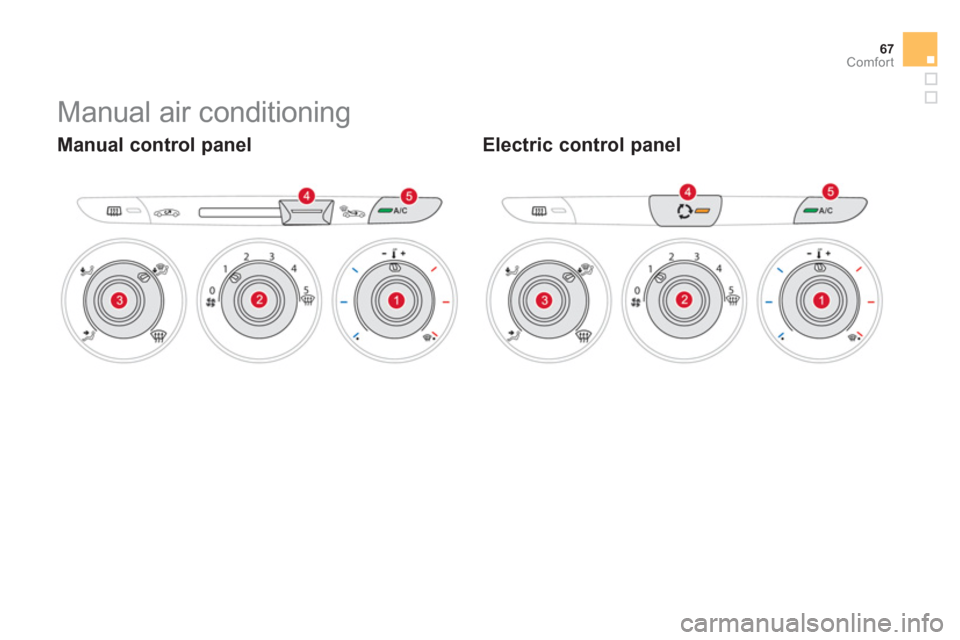
67Comfort
Manual air conditioning
Manual control panel Electric control panel
Page 70 of 324

The heating/ventilation or air conditioning systems operates with the engine running, as well as in STOP mode with Stop & Start.
1. Temperature adjustment
�)
Turn the dial from blue
(cold) to red (hot) to adjust
the temperature to your
requirements.
2. Air fl ow adjustment
�)
Turn the dial from position 1
to position 5
to obtain a
comfortable air flow.
�)
If you place the air flow control
in position 0
(deactivation of the
system), the temperature is no
longer maintained at a comfor table
level. However, a slight flow of air,
due to the movement of the vehicle,
can still be felt.
3. Air distribution adjustment
Windscreen and side windows.
Windscreen, side windows and
footwells.
Footwells.
Central and side vents.
The air distribution can be
adapted by placing the dial
in an intermediate position.
4. Air intake/Air recirculation
The intake of exterior air avoids the formation of
mist on the windscreen and side windows.
The recirculation of interior air insulates the
passenger compar tment from exterior odours
and smoke.
Return to exterior air intake as soon as possible
to prevent deterioration of the air quality and
the formation of mist.
Manual control panel
�)
Move the manual control to
the left to be in the "recycling
interior air" position.
�)
Move the manual control to the
right to return to the "fresh air
intake" position.